#Dominic Hanga
Explore tagged Tumblr posts
Text





Real Madrid announced the departure of Petr Cornelie, Adam Hanga, Nigel Williams-Goss and Anthony Randolph.
Along with them, we are saying goodbye to Estelle Chalopin and Hana June, Petr's wife and aughter, to Alexandra, Aylie, Sasha and Dominic Hanga, Adam's wife and children, to Kirstyn Thomas and Naz Alexander, Nigel's wife and son and to Marisela Fernández, Kayla and Julian, Anthony's wife and children. I wish them all the best for the future.
(basketball)
#Petr Cornelie#Estelle Chalopin#Hana June Cornelie#Adam Hanga#Alexandra Hanga#Aylie Hanga#Sasha Hanga#Dominic Hanga#Nigel Williams Goss#Kirstyn Thomas#Naz Williams Goss#Anthony Randolf#Mari Fernandez#Kayla Randolph#Julian Randolph#Real Madrid basketball
1 note
·
View note
Text
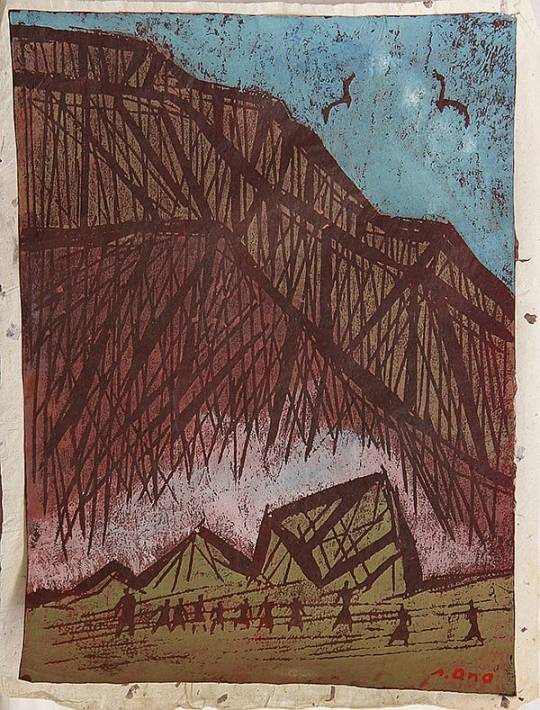
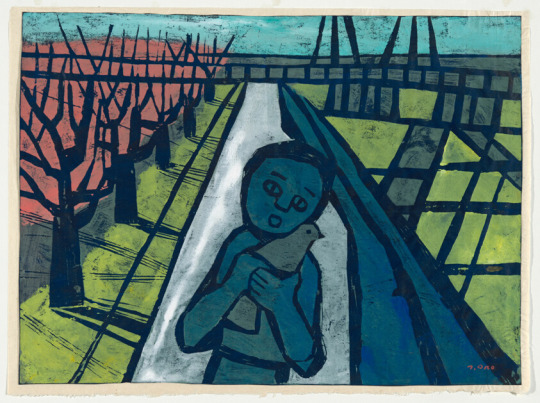
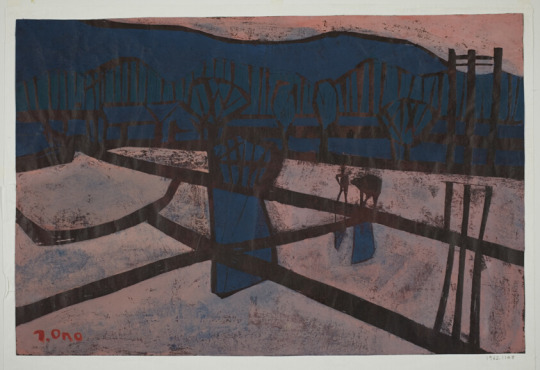



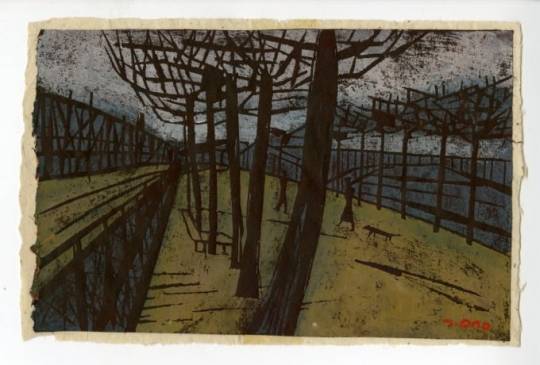

Ono Tadashige is a leading representative of Japanese postwar printmaking. His art style was strongly influenced by the movement of social-critical prints that was wide-spread in the 1920s and 1930s in Germany, Russia, China and also in Japan as the 'proletarian and farmers art movement'.
Ono Tadashige was born on January 19, 1909, in Tokyo, Japan. He had studied art at the Hongo Art Institute from 1924 until 1927. In 1941 Ono Tadashige graduated from the department of Japanese and Chinese languages of Hosei University Higher Normal School. At a young age he became an active member of the sosaku hanga and the proletarian art movement.
After the end of the Pacific War the artist's International career began. His prints were accepted for several of the International Print Biennials - 1957 in Tokyo and 1961 in Moscow. Ono Tadashige became a visiting professor at a couple of Japanese universities - Tokyo University of Fine Arts, Aichi University of Fine Arts, Hiroshima University, and Utsunomiya University.
The artist published several books on modern Japanese hanga and one book on Chinese prints.
Ono died October 17, 1990.
Prints - Style and Technique
The early prints made by the artist, meaning before world war II, were deeply rooted in the social-critical movement of German expressionism and the art trend dominating in Russia and among critical, intellectual circles in China (Luxun).
At the same time, there was a similar art movement in Japan, led and nurtured by Kanae Yamamoto (1882-1946), who is considered the founding father of the sosaku hanga movement. When Kanae Yamamoto tried to return from Europe to Japan in 1916, while world war I was raging, he stopped in Moscow for several weeks, and experienced the beginning of the Russian revolution. Back in Japan, Kanae Yamamoto pursued utopian socialist ideas by founding such projects like "Japan Children's Free Painting Society" or the "Farmers' Art Movement".
This was the background which had formed the character and art style of Ono Tadashige. After the end of the Pacific War, Ono Tadashige's enthusiasm for the ideas of proletarian revolution had lessened, but the way he saw his environment had not changed much.
His favorite subjects were town views of the industrialized areas - factories with tall chimneys, canals with tug-boats. The artist does not show a beautified Japan, but the Japan of industrialized cities.
Ono Tadashige's technique and style is congruent with his subjects. The colors used, are somber with much use of dark brown and black. And while a printmaker usually starts to print the light colors and then adds or overprints the dark colors, Ono Tadashige did it the other way round.
He began the printing process by darkening the paper with black ink. The light and white colors added on top of the black background gave them a kind of opaque effect, which is so typical for the art prints of Ono Tadashige.

18 notes
·
View notes
Text
art by ukiyo-e-heroes
1 note
·
View note
Text
Moment Of Peace (Ghoeyash Remix)
youtube
From the annals of the Particles back catalogue, "Moment Of Peace", from Russian artist, Mobilize, was a three-track EP of the highest order and forming part of a stunning repertoire of original tracks that ran across both Particles and the avant garde, Apollo, imprints. Revisiting the iconic track, Yin :: Yang now commission remixes from Hungary's finest.
From his home in the Budapest capital, Balint Gulyas, has become a well-respected figure in the world of progressive house. A classically trained musician, well-versed in music theory, his concert performances as an accomplished pianist stood him in good stead as he turned his attention to electronic music and the deep and progressive house genres in 2012. A regular on the Clinique imprint after an "Inspired" debut, quickly led to work for Stellar Fountain, BQ Recordings and Perfect Session.
Making his debut for Yin, the Ghoeyash remix thus delivers a mature reworking of "Moment of Peace". Taking the central themes of Mobilize's strongly percussive offering, a host of additional production work creates a track that bristles with emotion through pulsating bass line and textured pads. Moving forward at rapid pace, shimmering melodies provide a moment of reflection at the mid-point before the dominant kick and dynamic groove find their place once more in the second half.
Directed/AandR by Tripp Baronner Mastered by Hanga SoundLab LTD | hangasoundlab.com Design by * caption | followthecaption.com Text by James Warren
released November 07, 2016 by Yin
0 notes
Photo
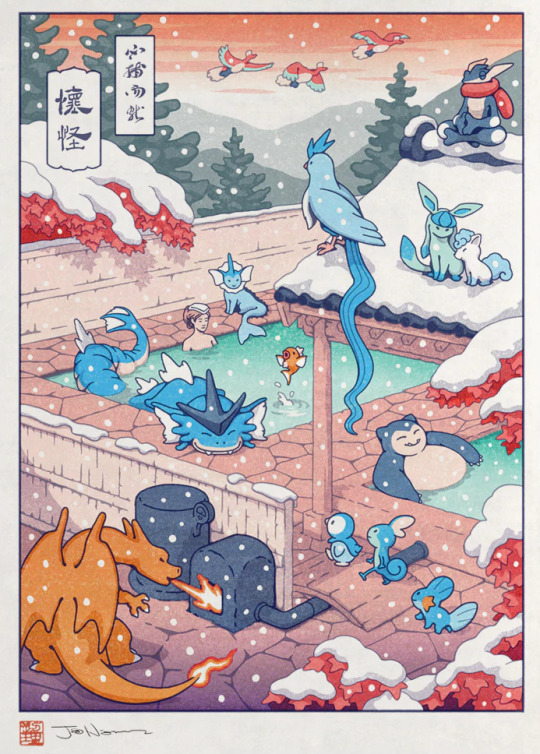
Winter Hot Spring, by Jed Henry.
This piece was done in a modern shin-hanga style, which was dominant in the early 1900s at the peak of Japanese woodblock technique. Shin-hanga prints are known for their intricate realism, and require many dozens of impressions with hand-carved wood blocks. It was a ton of work to make those prints, but the low yen compared to higher valued European currencies in the early 1900s made it economically viable.
The left caption translates to 'pocket' and 'monster'.
The right caption is an excerpt from the Kojiki, one of Japan's oldest written works from the early 700s. The line translates to 'I vow that I shall catch'.
#art#jed henry#pokemon#ho-oh#articuno#greninja#vaporeon#gyarados#glaceon#vulpix#snorlax#charizard#magikarp#piplup#mudkip#sobble#winter
3K notes
·
View notes
Text
1Direksyon: Mula sa entablado, papunta sa kamalayan ng buong mundo
Isang blog post tungkol sa One Direction: This Is Us (2013) at ang implikasyon ng mga eksena nito sa naging kamalayan ng mundo sa panahong iyon.
“Ma, dali na! Malelate tayo sa sinehan!”, sabi ko sa aking ina na pumipili pa lamang ng susuotin sa araw na iyon. ‘Di na ako mapakali, sapagkat ang araw na iyon ay ang unang araw ng pagpapalabas ng One Direction: This Is Us sa mga sinehan sa Pilipinas.
Hindi maipapagkaila na malaki akong taga-hanga ng bandang iyon. Lagi akong naka-antabay sa Twitter, nag-aabang sa bagong tweet mula sa sinumang miyembro, o kaya’y ako ay magpupuyat hanggang alas-tres ng umaga para lang hintayin ang bagong labas na music video sa Youtube. Kung kaya’t sa pagpalabas ng kanilang pinakaunang dokumentaryo, ako rin ay laging nangunguna sa pila.
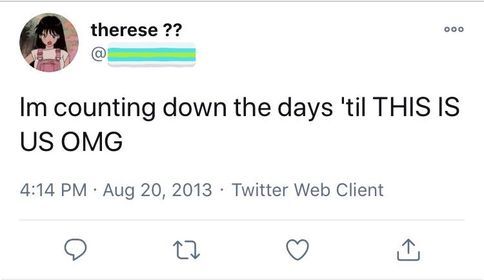
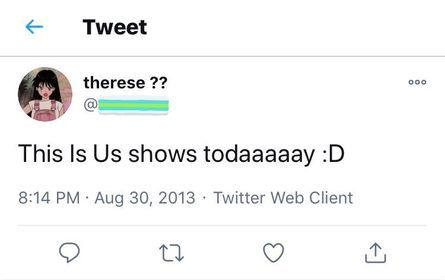
(opo, nagmula ang mga larawan na ‘yan sa aking Twitter fan account.)
Pagkaalis ng aming bahay, sinundo namin ang aking kaklase na gusto ring manood ng naturang pelikula kasama ko. Matapos naming dumating sa Robinson’s, ay agad-agad kaming umakyat sa sinehan para makakuha na ng tiket at makapasok na sa sinehan. Pagkapasok namin sa sinehan, nakita namin na punong-puno ang kwarto ng mga panatiko ng One Direction. Bata ‘man o matanda, babae ‘man o lalaki, suot-suot nila ang mga t-shirt na may mukha ng banda at tila’y nakikipagdaldan sa isa’t-isa na parang matagal na nilang kilala ang bawat isa.
Hindi rin nagtagal, at tuluyang nagpatay na ng ilaw sa sinehan. Nagsimula na ang pelikula, at sabay-sabay nagtilian ang mga tao sa loob nito. Kitang-kita sa mga mata (at rinig na rinig sa sigaw) naming mga taga-hanga ang kasiyahan (na may kasamang kilig) na makikita na namin ang bandang nagpapasiya sa amin. ‘Di man sa personal, ngunit iba pa rin ang dating kapag nakita mo sila sa malaking screen ng sinehan at hindi sa mga maliliit naming telepono.
Ang “One Direction: This Is Us” ay isang patunay ng makabagong potensyal ng social media noong panahong iyon. Kung iisipin, halos kakasimula pa lamang ng kasikatan ng Twitter, Facebook, at Youtube noon, ngunit nagamit ng tao ang mga ito upang mabilisang at malawakang magpalaganap ng impormasyon.
Sa simula ng pelikula, isinalaysay muli kung paano nagsimula ang One Direction. Mula sa kanilang pagkabuo sa X-Factor UK noong 2010, nagsimulang dumami ang kanilang mga taga-hanga. Natalo ‘man sila sa taong iyon, ay lalong sumikat ang One Direction, salamat sa kanilang mga superfans.
Ika nga ni Simon Cowell, ang kanilang manager, “We have these girls, called superfans, and they’re like promoters.” Buhat ng social media, naimpluwensyahan ng mga panatikong iyon ang iba pang mga tao na humanga at sumubaybay sa buhay ng One Direction. Dahil sa mga Twitter update accounts na laging nagpopost sa tuwing mga bagong ganap sa banda, nagsimulang madiskubre ng mga ibang Twitter user mula sa iba’t-ibang parte ng mundo ang mga artistang ito.
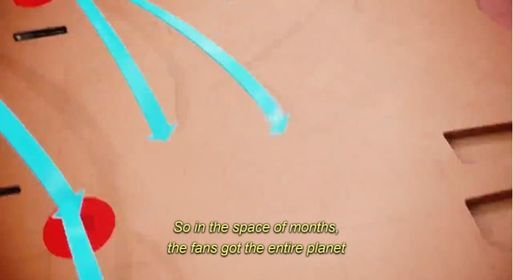

Sa pagbuo at paglikha ng mga update account, ay nakita ng mga tao ang potensyal ng social media bilang isang plataporma para sa malayang pamamahayag.
Sabi ng mamamahayag na si Carl Smith, lagi silang sumasangguni sa mga update accounts na ito upang malaman ang mga bagong balita tungkol sa banda. Dagdag pa niya, “siyam sa sampung pagkakataon ay mas nauuna pa ang mga account na ito sa pag-ulat ng balita tungkol sa banda bago pa ‘man malaman ng pahayagan o ahensya ng balita.”


Ngunit sa kabila ng pagbilis ng pagkalap at pagkalat ng impormasyon gamit ng social media ng panahong iyon, ay nagsimula rin ang pagkawala ng pagkapribado ng buhay ng ibang tao, lalong-lalo na ang buhay ng mga miyembro ng One Direction. Ilang halimbawa ay ang pag-hack ng ilang panatiko sa iba’t-ibang CCTV para lang makita ang banda, at ang isang insidente kung saan ninakaw ng ilang fans ang boxers ng isang miyembro mula sa balkonahe ng kanilang tinutuluyang hotel.
Pagkatapos ikwento ang pinagmulan ng One Direction, ay nakipanayam ang production team ng pelikula sa iilang taga-hanga ng banda sa iba’t ibang parte ng mundo. Nang tanungin kung bakit nila hinahanga ang bandang ito, dali-daling sinabi ng mga taga-hanga,
“They make me so happy.” “When I’m sad, they’re always here for me.” “They say what we want to hear, and no one says [that] to us.” “I know they love me, even [if] they don’t know me, I know.”
Ang ganitong mga tugon ay bunga ng marketing strategy binuo ng promotional team ng banda. Ang pagtagumpay ng One Direction sa pagkakaroon ng maraming album sales at sold-out concerts ay ang paggamit ng emotional marketing sa madla. Dahil karamihan ng tagapag-hanga ay mga bagets, pinukaw ng banda ang kanilang mga emosyon sa pamamagitan ng pagbuo ng kantang emosyonal [na parang kinakausap sila, tulad ng kantang ‘Little Things’], at ang paggamit ng kanilang social media accounts upang makausap at makipag-ugnayan sa mga panatiko.
Ipinakita rin sa pelikula ang naging epekto ng banda sa pagbuo ng mga online community na binubuo ng kanilang mga taga-hanga. Tinalakay ang isang magandang naidulot ng One Direction sa aspekto ng online communities: ang pagbuo ng mga pagkakaibigan. Sabi nga ng isang fan sa pelikula, “[The] best part of being a fan of One Direction is the friends you make through them”. Tunay na nakakahanga ang naging kakayahan ng internet sa pagtatagpo ng mga tao base lamang sa kanilang kinakahiligan.
Pinag-usapan sa pelikula ang mga fan project na isinasagawa ng mga fans sa araw ng concert. Pinagpaplanuhan ito ng mga dadalo sa concert ilang linggo bago ang araw ng naturang concert. Ito ay pinag-iisipang mabuti, at ipinakakalat ng mga fans sa pamamagitan ng pagpost sa Twitter.
Ang mga miyembro rin ng One Direction ay bumuo ng kanilang sariling fan project noong sila ay nagtanghal sa Amsterdam. Ipinakita sa video na nag-tweet ang ilang miyembro na magsuot ang mga pupunta sa kanilang concert ng kulay kahel na damit. Naging matagumpay ang plano ng banda, sapagkat lahat ng dumalo ay nagsuot ng kahel. Ang mga ganitong tagumpay ang isa sa mga naunang patunay sa kapangyarihan ng internet na magtipon at mag-organisa ng mga tao para sa iisang layunin.


Sa bandang dulo ng pelikula, tinalakay ng banda ang kanilang pinakamalaking takot: ang kanilang paglaho pagdating ng panahon. Sa pelikula, nag-usap usap ang limang miyembro ng banda matapos ang kanilang concert sa Sweden. Sabi ni Louis Tomlinson, “One day, we’d just not do this anymore”. Dagdag pa ni Niall Horan, “There’s been so many bands that have come and gone, and no one really talks about them anymore.” Bagama’t tanggap na nila na darating din ang araw na ito, inaasahan nila na sana’y maalala pa rin sila at ang mga kantang ginawa nila pagdating ng panahon.

Isa ito sa lumalabas na problema ng pagbilis ng teknolohiya. Buhat ng lalong pagkabilis ng pagproseso at paglabas ng impormasyon, mabilis maglaho ang pagbigay-pansin sa mga bagay-bagay. Kinumpirma ito ng manunulat na si Dakota Shane, noong sinabi niya’y “The social media landscape moves fast. The second you think you've figured it out, your favorite social media platform alters their algorithm.”
Bago matapos ang pelikula, sinabi ni Niall Horan sa isang concert sa Mexico, “You guys have been right here since day one. It means so much to us because none of this would happen without you.”
Pitong taon na ang nakalipas magmulang ipalabas ang pelikulang ito. Nagkahiwa-hiwalay na ang landas ang limang miyembro ng One Direction. Malungkot ‘man ang nangyari, lagi kong inaalala ang sinabi ni Niall sa pelikulang ito. Ang mga masugid na tagahanga ng One Direction (katulad ko) ang nakapagbago ng mga buhay nila. Nakakatuwang isipin na lahat ng nakamit ng One Direction ay hindi mangyayari kung hindi kami napabilib sa kanilang potensyal magmulang sila ay natalo sa X-Factor.
Nakakatuwa ‘ring isipin na kaming mga tagahanga nila ay naging parte rin ng kasaysayan. Dahil sa pera, oras, at pagod na ginastos at ginugol ng mga tagahanga ng One Direction, maraming naabot ang banda. Iilan lamang dito ay ang:
First group to debut at no.1 with their first four albums in the US
First UK group to debut at No.1 in the US with a debut album
Most Followers on Twitter for a music group
Most subscribers for a band on Youtube
Oo, napabago namin ang buhay nila. Pero kung iisipin, binago rin nila ang buhay namin.
Sanggunian:
Greenwood, D. (2020, July 23). How One Direction became the world’s first internet boyband. The Independent. https://www.independent.co.uk/arts-entertainment/music/features/one-direction-10-years-anniversary-social-media-x-factor-fandom-a9632291.html
Haney-Claus, M. (2016). One Direction and the Marketing Machine One Direction and the Marketing Machine. https://scholarworks.wm.edu/cgi/viewcontent.cgi?article=1986&context=honorstheses
Hit Network Australia. (2020, July 24). An Ode to The Greatest Boyband on Their 10 Year Anniversary. Hit Network. https://www.hit.com.au/story/an-ode-to-the-greatest-boyband-on-their-10-year-anniversary-158354
Santero, N. (2016). “Nobody Can #DragMeDown”: An Analysis of the One Direction Fandom’s Ability to Influence and Dominate Worldwide Twitter Trends. https://digitalscholarship.unlv.edu/cgi/viewcontent.cgi?article=3731&context=thesesdissertations
Stopera, M. S., Dave. (2019, November 8). 23 Of The Craziest And Scariest Things One Direction Fans Have Ever Done. BuzzFeed. https://www.buzzfeed.com/mjs538/what-a-time-it-was
(sir, salamat. aliw na aliw ako sa pagsulat muli tungkol sa one direction.)
1 note
·
View note
Text
What to Do, See, Eat on Rapa Nui Including Moai Statues

Rapa Nui, otherwise known as Easter Island (or Isla de Pascua), is one of the most remote inhabited places on the planet. It's hard to find on a map — the island is little more than a stray dot in the vast southeastern Pacific Ocean. Its closest neighbors are the tiny Pitcairn Islands (some 1,200 miles away), while the nearest continental point is Chile, which is 2,200 miles to the east — or five hours by flight. Map of Easter Island, or Rapa Nui. Despite its extreme seclusion, most people know of Easter Island for one reason: the moai sculptures. And they are enough to attract nearly 100,000 travelers every year to this island of just 5,700 inhabitants.
Touching down in the middle of nowhere
Approaching by plane, three distinct volcano craters emerge on a triangle of green grass fringed by black coastline. Everything else — in all directions — is barren blue ocean. Aerial view of the Ranu Kao volcanic crater. Patricia Hamilton Flights arrive at Rapa Nui's small Mataveri Airport in the town of Hanga Roa. The feel here is instantly more Polynesian than Chilean, despite Chile's annexation of the island in 1888. Aside from the language, imported food and household goods, the connection between Rapa Nui and Chile is obscure. Most of the island's population are of Polynesian descent and many still speak a local dialect, in addition to Spanish. And the most famous inhabitants — the stone-faced moai — have no connection to Chile at all.
The moai of Rapa Nui
Enormous and iconic, the cartoon-like moai statues scatter the windswept island as sentient guardians of the local culture. Their porous, basalt surfaces look featureless and ancient, yet their stature gives them lifelike attributes and a sense there is more to them than meets the eye. After being in their presence long enough, the rock effigies seemingly come alive. Visitors can get close — but not touch — the moai sculptures. Kevin Cox What is surprising is the number of moai on the island, in popular places and lesser-known locations. Seeing the sculptures is simple — visitors can walk right up to them — but touching the moai is strictly forbidden, as they still have great religious significance to the locals. At Rano Raraku, believed to be the quarry where most of the moai were carved, roped-off pathways lead up the volcanic hillside where hundreds of heads protrude from the soil, complete bodies lean at awkward angles, and ruined or unfinished sculptures lay on their sides. Wandering among the statues reveals subtle differences between them — each one unique in appearance and personality. Feral horses wander freely around Rano Raraku, where some moai sculptures lean or have toppled over. Kevin Cox Many still wonder how such prodigious statues — which date as far back as the 11th century and range from 3 to 11 meters (10 to 36 feet) tall — were moved to so many locations around the island. Archaeologists and engineers have tried, unsuccessfully, to find the answer. Some people believe it to be the work of aliens from another world. These mysteries add to the moai's enduring allure.
A trio of volcanoes
While the moai tends to dominate international attention, it's Rapa Nui's dramatic coastline that truly mesmerizes. Rapa Nui's coastline. abriendomundo Jagged volcanic rock forms a crusty perimeter around the island, with inlets that are rhythmically thrashed by the ocean waves. Royal blue water contrasts with brilliant white surf, as tides race in and roar violently against the black cliffs, spraying water high into the air. There are three principal volcanoes which form the highest points of Rapa Nui, but only one — Rano Kau — can be comfortably reached without a guide. It is home to a small museum and visitor center located in the restored ceremonial village of Orongo. Beyond the village, visitors can sit on the rim of the volcano for unobstructed views 400 meters (1,312 feet) into the crater. There is also the option to comfortably stroll along the volcano's summit to nearby cliffs that overlook two notable islets — Motu Iti and Motu Nui — that shoot up from the deep sea less than one mile from the shore. The crater of the extinct volcano, Rano Kau. Kevin Cox To reach the other two volcanoes, a guide can be easily arranged by most hotels for an even more remote island experience. It's here, in the moments away from other tourists, where you feel alone in a place the rest of the world forgot.
More than just moai
Contrary to common assumption, Rapa Nui is not a beachcomber's paradise. With more cliffs than beaches, the island offers only two choices. Anakena is the main beach; this small cove of beige coral sand is located next to a park with shacks serving fresh food and drinks. A grassy slope of swaying palms leads to the beach and Ahu Nau Nau, a platform of seven ancient Moai once buried in sand, but which now watch over the bustling bathers below. The less populated Ovahe Beach is just around the edge of the cove and is a good spot to escape the crowds. One of the seven moai of Ahu Nau Nau, with Anakena beach in the background. Atlantide Phototravel Hiking and biking opportunities on the island are plentiful, each leading to archaeological ruins, more Moai or eye-popping vistas. Guidebooks and maps are useful for self-guided circuits to see the sights by car or on foot. There are hundreds of underground caves formed by lava flows, a few of which can be safely explored by non-spelunkers. Ana Te Pahu — the largest lava tube on the island — allows more than one kilometer of subterranean exploration. Near the coastline, the 50-meter (164 feet) Ana Kakenga, known as the "cave of two windows," ends at two jagged holes that peer out to the sea. One of two openings of the Ana Kakenga cave. jimfeng Despite their popularity and well-marked access, the caves are not for everyone. As paths are slippery and lighting is poor, hiking shoes and a flashlight are recommended for those who want to explore them.
Sunrises and sunsets on Easter Island
A benefit to renting transportation is the ability to witness the remarkable sunrises of Rapa Nui from different points across the island. Each day, visitors and locals alike, make a pilgrimage to the edges of the island to enjoy the magnificence of dawn. Sunsets on Rapa Nui. Buena Vista Images To revel in all of nature's glory, it's best to avoid the crowds at the usual places, such as the remarkable 15 moai platform of Ahu Tongariki, where buses of tourists arrive each morning. Instead, head to a remote oceanside spot to witness the pastel pink sky rise above the sea. For a nightcap, sunset at the grassy Ahu Akivi — one of the island's few inland moai platforms — offers an inspiring view of seven Moai staring directly into the sinking sun.
Sensational seafood
A benefit to being so far out at sea is the plenitude of fresh seafood. Independent fishermen glide up to the two little wharfs on the edge of town with their daily catch of red kana kana and some of the best deep-water tuna one can find. Visitors can buy fish from the fishermen at modest prices. Nearly every restaurant serves seafood in some form, including mahi mahi, lobster and even snails from the rocky coastline. The tuna ceviche is not to be missed, with herbs, avocado and meaty cubes of tuna so fresh they're almost crunchy. Tuna ceviche so fresh it's "crunchy." Kevin Cox For cheaper eats, go for a tuna empanada with its golden crust and perfectly cooked chunks of fish within; they're best bought from food carts on Policarpo Toro Street on the island's waterfront.
Tips
Getting there Presently, to get to Rapa Nui by air, travelers must either start in Chile or French Polynesia. There are daily flights from Santiago, and one flight weekly from Tahiti, both on Latam Airlines. Getting around Rapa Nui can easily be explored independently to fully appreciate both the moai and the island's natural beauty. Navigating is easy, as there is one main road that leads to the most popular archaeological sites. The remaining roads, located along the shorelines and deeper into the island, are primarily made of dirt or gravel. The best automobile option is an SUV, which are plentiful at the rental agencies in town. Mountain bike rentals and horseback tours are a popular way to explore remote locations such as Maunga Terevaka — the island's tallest volcano — and to visit other places where cars are not allowed. There are over 1,200 documented petroglyphs — or rock carvings — on Rapa Nui. Kevin Cox Renting a four-wheeled ATV gives the greatest access to narrow dirt tracks leading to desolate roads that hug the coastline. There, small ahus (platforms that once supported moai sculptures), scattered remains of settlements, moai ruins and petroglyphs are largely overlooked by tourists and can be explored with nothing but a map and the sound of the sea in the background. Where to stay Rapa Nui has a number of intimate luxury hotels, ecolodges and hostels for nearly any taste. For high-end Polynesian comfort, there is the Hangaroa Eco Village & Spa beside the sea or the Explora Rapa Nui in the hills. Other visitors to Rapa Nui opt to rent bungalows or cabanas; they allow for more privacy and space as well as an independent Easter Island experience. Read the full article
0 notes
Photo



Since my screaming makes little sense to anyone but me: my theory about Kugane is that the devs have based it on the Bakumatsu and early Meiji periods.
The new Sekiseigumi (ty @mythrilreflections for telling me abt them) is likely based on the Shinsengumi that’s been made famous over the recent decade bc of tons of media coverage. There are a TON of inaccuracies in most English sources about them including that Wiki article, so please be wary.
They were essentially a police force that emerged from the Roshigumi, which was made of, yes, roshi, but also a bunch of random and untitled men. The group was rowdy, hot-headed, and violent due to this unorthodox mix (which is why the public dislikes them, like the old lady saying they’re gonna kill everybody), but they were also a deeply loyal, virtuous, and interesting group once they purged their ranks more than a few times.
It’s a bit strange that they are guarding Kugane Castle, but for all we know they could have been assembled by the Imperial Court instead of an outside daimyo like the Matsudaira of Aizu. If that’s the case, it can be an even greater incentive for the common people to see the Sekiseigumi as not only bullies, but spies or smth of that nature.
Then there’s the Thavnairian and Garlean consulates, which relate to people like Townsend Harris, the entitled mister (don’t suffer yourself to read his diary) who secured trade with Japan after Commodore Perry rattled the isolationist nation with his Black Ships.
The result is that we get this really wild mix of traditional Japanese culture and the emerging domination of Western culture beyond warfare as it takes over the more important buildings (and fashion. rip geisha.) while everybody and their mother overseas just wants a look at a Mount Fuji. Artists: check out shin-hanga. Everybody else: sell whatever else you have bc Ishgard is going to want your weird trinkets.
That said, I don’t think this will go very far and copy the eventual demolition of the entire social, political, and physical infrastructure of Japan (literally in the case of the castles). That’d put the samurai in too awkward a position and make them more like DRKs (or just everybody can become a roshi and even more of an asshole).
PS: The Sanjo Hanamachi in the north sector of Kugane means geisha, yujo, and kabuki are likely confirmed!!
#LAYS DOWN#I tried to make sense#i really want some sonno joi up in here#(its not gonna happen)#but the /POSSIBILITIES/#just#please#dont abuse othard#brianna babbles
76 notes
·
View notes
Text
INCEPAND DE ASTAZI Obligaţiunile Agroland intră la tranzacţionare la BVB
New Post has been published on https://reporterliber.ro/incepand-de-astazi-obligatiunile-agroland-intra-la-tranzactionare-la-bvb/
INCEPAND DE ASTAZI Obligaţiunile Agroland intră la tranzacţionare la BVB
Obligaţiunile corporative emise de Agroland Business Systems (AGR25), societatea care operează lanţul de magazine agricole Agroland, intră la tranzacţionare începând de astăzi prin Sistemul Multilateral de Tranzacţionare (SMT) al Bursei de Valori Bucureşti (BVB), la trei luni după închiderea cu succes a ofertei, se arată într-un comunicat al operatorului pieţei noastre de capital.
Agroland este de altfel prima reţea de magazine agricole care face pasul pe piaţa de capital din România. Societatea a derulat în perioada 3 – 5 martie un plasament privat de obligaţiuni prin care a atras 8,08 milioane lei. Obligaţiunile au o maturitate de 5 ani (10 martie 2025) şi o dobândă fixă de 9% pe an, plătibilă semestrial.
Radu Hanga, preşedintele Consiliului de Administraţie al BVB, a precizat: „Agricultura este unul dintre cele mai importante sectoare ale economiei româneşti, fapt dovedit şi de construcţia PIB-ului pe 2019, în care agricultura a reprezentat 4,1% din PIB-ul României, adică 10 miliarde euro. Ne bucurăm să vedem companii precum Agroland că vin pe piaţa de capital pentru a atrage finanţarea necesară pentru dezvoltare şi adaptarea la noile cerinţe ale pieţei. Runda de finanţare derulată cu succes de Agroland, chiar la începutul lunii martie, când pe pieţele de capital începeau să se simtă primele semne de tensiune, dovedeşte că investitorii sunt dispuşi să investească întotdeauna când identifică o oportunitate. Aceasta dovedeşte, totodată, că Bursa de Valori Bucureşti este un pilon esenţial pentru accesarea capitalului necesar dezvoltării companiilor şi, implicit, a economiei locale”.
Agroland va utiliza capitalul atras pentru finanţarea dezvoltării magazinelor de format nou, modernizate, cu suprafeţe de 400 mp. Acest nou tip de magazine are ca scop satisfacerea atât a nevoilor clienţilor tradiţionali, cât şi a unui nou segment de clienţi, cu venituri peste medie şi având hobby-uri precum grădinăritul, creşterea animalelor de companie sau de expoziţie/fermă, potrivit comunicatului.
Horia Cardoş, fondatorul şi administratorul Agroland, a precizat: „Doresc să mulţumesc investitorilor pentru încredere şi să îi asigur că au luat o decizie inspirată investind în Agroland. În aceste vremuri instabile, modelul de business al Agroland prosperă. Veţi vedea deja în raportările pentru primele 6 luni din 2020 rezultate excelente, pe care sperăm să le replicăm şi în următoarele semestere”.
În cadrul plasamentului privat derulat de Agroland au fost emise 80.803 obligaţiuni, care au fost cumpărate de 88 de investitori, dintre care 87 de investitori de retail şi un investitor institutional. Dintre cei 87 de investitori de retail, 86 sunt persoane fizice şi un investitor este persoană juridică română.
Plasamentul privat şi admiterea la tranzacţionare a obligaţiunilor au fost asistate de Tradeville, în calitate de Consultant Autorizat.
Ovidiu-George Dumitrescu, director general adjunct şi coordonator al diviziei de finanţări corporative a Tradeville, a afirmat: „Listarea obligaţiunilor Agroland demonstrează încă o dată că şi în România bursa este o soluţie pentru finanţarea economiei naţionale. Şi nu doar pentru companiile de nişă (ex. IT sau finanţe), ci pentru orice tip de firmă care are cel puţin aceste 3 lucruri: un istoric pozitiv, o organizare bună şi o viziune de dezvoltare solidă. În acest sens, suntem mândri că Tradeville este parte dintr-un număr tot mai mare de astfel de proiecte şi ne bucură să vedem un interes în creştere pentru finanţarea la bursă. Sper ca optimismul să fie factorul dominant în continuare şi să avem ocazia să aducem faţă în faţă cu investitorii potriviţi cât mai multe companii de succes”.
Reţeaua de magazine agricole acoperă segmentele „Ferma”, „Pet Care” şi „Gardening”, iar de curând a intrat şi pe segmentul de fitofarmacii. Totodată, Agroland este cel mai mare furnizor din domeniu de pui de o zi. Vânzările de furaje şi pui au cele mai mari ponderi în vânzările Agroland, de 34,08% şi, respectiv, de 23,49%, potrivit datelor pentru anul 2019. În acelaşi timp, compania câştigă teren de la an la an segmentul de „Pet Care”, care în anul 2019 a ajuns la 12,36% din venituri. În această etapă, Agroland evoluează de la magazine tradiţionale, cu suprafeţe cuprinse între 50-100 mp, către magazine specifice retailului modern cu suprafeţe de 400 – 500 mp.
Înfiinţată în anul 2009, societatea operează în prezent o reţea extinsă de magazine la nivel naţional, acoperind 28 de judeţe din Romania. La finalul lunii februarie, Agroland deţinea 247 de magazine, dintre care 57 operate direct şi 190 de magazine aparţinând francizaţilor. Societatea este prezentă şi în segmentul de comerţ on-line, unde sunt estimate vânzări de 400.000 de euro în acest an.
Agroland estimează că în cele 28 de judeţe în care este prezentă, pentru oraşele mici şi zonele rurale, deţine o cotă de piaţă de aproximativ 30%.
Agroland Business Systems a încheiat anul 2019 cu o cifră de afaceri de 133,6 milioane lei, un profit operaţional de aproape 3,8 milioane lei şi un profit net de 2,4 milioane lei. Societatea estimează că cifra de afaceri va consemna un ritm ascendent în următorii cinci ani, astfel că, în 2025, anul în care obligaţiunile vor ajunge la scadenţă, cifra de afaceri va fi de 222,6 milioane lei.
Horia Cardoş, fondatorul şi administratorul unic al companiei, deţine 90% din societate, în timp ce un alt pachet de 10% este deţinut de Ştefan Martin.
0 notes
Photo

Adam Hanga with his children
(basketball)
0 notes
Photo




Iwami Reika, pioneer in the post-WWII male-dominated world of Japanese print-making, is the first Japanese woman print artist “to achieve the same status and worldwide recognition as male artists.”
While born in Tokyo, her early years were spent on the Island of Kyūshu Returning to Tokyo, but unable to afford regular art classes, she attended Sunday art courses, including printmaking, at Tokyo’s Bunka Gakuin College, graduating in 1955. Before coming to printmaking she tried oil painting and studied doll-making under the “National Treasure” Hori Ryūjo 堀柳女 (1897–1984). While having an early interest in prints, it was not until after seeing the work of the sosaku hanga (creative print) artist Onchi Kōshirō (1891-1955) in 1953-1954 that she took up the study of printmaking, studying with Onchi’s associates Sekinō Jun’ichiro (1914-1988) and Shinagawa Takumi (1908-2009). By the mid-1950s, Iwami had “discovered a natural affinity for the paper, wood, and watercolor, and felt that she had found her artistic niche in the execution of woodblock prints.”
10 notes
·
View notes
Text
art by ukiyo-e-heroes
0 notes
Text
art by ukiyo-e-heroes
1 note
·
View note
Photo

Adam and Dominic Hanga (basketball)
0 notes
Text
Congratulations to Adam Hanga and Alexandra for the birth of their baby boy, Dominic !

(basketball)
0 notes